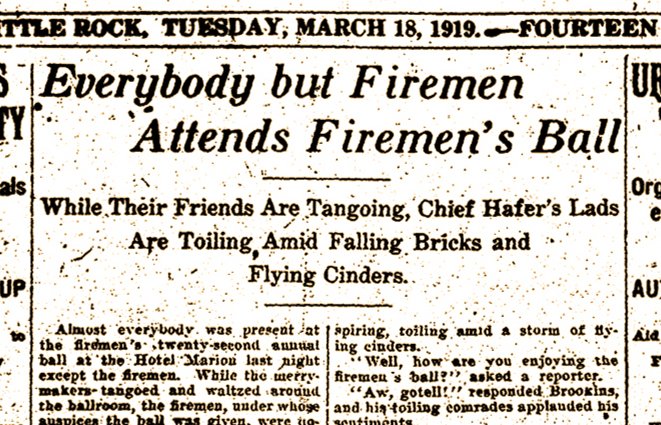A hundred years ago, Little Rock residents were making a poor show of their fire alarm efforts.
Fire was an ever-present hazard in a mostly wooden city illuminated by open flames and inefficient incandescent lamps on underinspected electric lines; and so you might imagine that residents would have known the alarm-sounding process by heart.
But on the morning of March 17, 1919, the Arkansas Gazette conveyed a detailed complaint from Fire Chief Charles Hafer to 1) the people, who did not know how to turn in an alarm correctly, and 2) to motorists, who were a general nuisance to the drivers of the fire apparatuses.
On Saturday night, he said, the squad phone rang out, summoning the firemen from their beds and onto their respective apparatuses.
Then they waited for the watchman to yell out the location of the fire, but five minutes elapsed, and still no order from him came. He finally emerged and said that the party had hung up.
To figure out where the fire was, he had to ask the phone operator to trace the connection, and by the time they reached the party to whom he had been speaking, that fire had been extinguished.
Sweet that it wasn't a serious fire, but not sweet that the firefighters lost their sleep. This was happening over and over. Therefore, the chief wished to give instructions:
When a fire was discovered, people should go to the nearest telephone to inform "central" — the central fire station, not a squad phone — that they wished to report a fire.
This will cause the telephone girl to give quick service.
Callers should not hang up until after telling the location of the fire, and telling it correctly, and also saying what kind of fire it was.
Keep cool, and tell it so the firemen can understand you plainly.
Within three seconds, he promised, an apparatus would be moving out of its station. And that is where the real trouble would begin.
The average motorist, he said, saw a firetruck speed up the street and fell in line, speeding with it.
Of course, this makes the race real interesting, but it imperils the lives of the firemen and others.
At most fires, other cars reached the scene first and blocked the hydrant.
Each company has its own plug to string to, and always drives straight for that particular plug. If the plug happens to be penned in by a row of automobiles, the men are forced to drive several blocks to lay in from another one.
If motorists wanted to help fight the fire, he said, they should keep away with their cars until the firemen connected their lines.
Also, the city did have an ordinance against racing the trucks. Motorists were to pull to the curb. Violation was punishable by fine. And there was an ordinance against parking within 15 feet of a fire plug, and also against driving a machine, wagon or vehicle of any kind over a fire plug.
By coincidence, I'm sure, March 17, 1919, was a big day for the city Fire Department.
GREAT BALL OF FIRE
As the Arkansas Democrat reported, finishing touches were being put on arrangements at the Hotel Marion for that night's Firemen's Ball — the 22nd annual. Either Hafer or Assistant Chief Charles A. Burns would lead the Grand March at 9 p.m., and dancing would continue until midnight.
Advance tickets had sold out, but tickets could be bought at the door.
The arrangements committee reserves the right to refuse admittance to anyone of bad reputation.
Hafer had scheduled things so every fireman could attend, in shifts. But as events unfolded, everybody but the firemen attended their ball.
Fire Sweeps a Block Causing $500,000 Loss
A fire that started on the top floor of the five-story Skillern Building, occupied by the Rose-Lyon Hardware Co., spread to other buildings in the block of Scott Street between Second and East Markham streets.
Skillern's south wall collapsed, smashing nearby buildings, including one that housed a confectionery, a dry goods shop, a cigar store and — yikes — two cotton brokers. Fire broke out there, too, but was extinguished.
Window sashes and awnings across the street ignited, so firemen trained their lines at that building — until water stood a foot deep on its third floor. Heat broke all the windows on all the other buildings fronting the flaming block.
As the ruins smoldered March 18, firemen dynamited the remaining walls.

By March 19, the enormity of the losses to the insurance companies was front-page news. But let's focus on the lost sleep.
After spending Monday evening with the fire at Second and Scott streets, as midnight approached, Company 2 was sent back to its station to rest and be ready in case other calls came. And one did, at 12:15 a.m. A lumber mill was ablaze.
Companies 2 and 6 saved the mill.
The next morning's Gazette reported that the fireman charged with selling tickets at the ball, Tillerman Brookins, instead fought the good fight. The Gazette gives him to us on the scene, grimy and perspiring, amid a storm of flying cinders.
"Well, how are you enjoying the fireman's ball?" asked a reporter.
"Aw, gotell!" responded Brookins, and his toiling comrades applauded his sentiments.

My favorite part of this story is the ads that appeared in print while the ruins were smoldering — if it's not indecent to find humor in such a costly catastrophe for a city that needed all the tax base it could get. One ad urged everyone to read their policies. Were they adequately covered? Did they want to upgrade?
Others advised customers that the stores were still in business.
One, in particular, tickles me: E.G. Levy wanted customers to know he had set up at Second and Scott, with Loeb Cigar. Not all of his cigars had burned, yet.
Email:
cstorey@arkansasonline.com
Style on 03/18/2019
